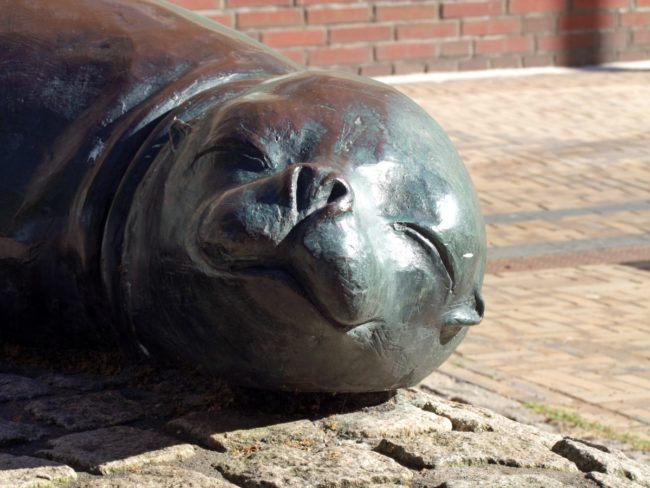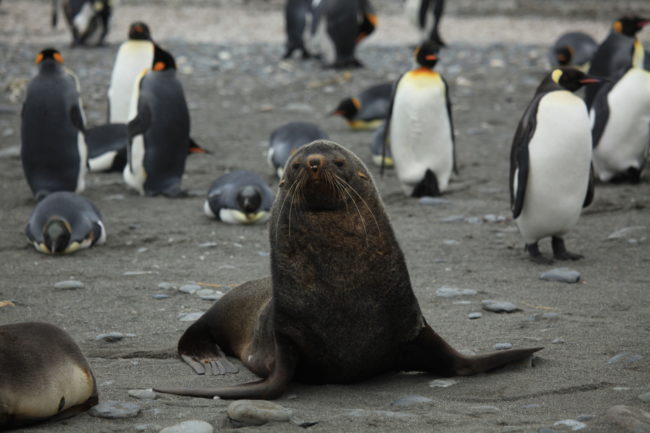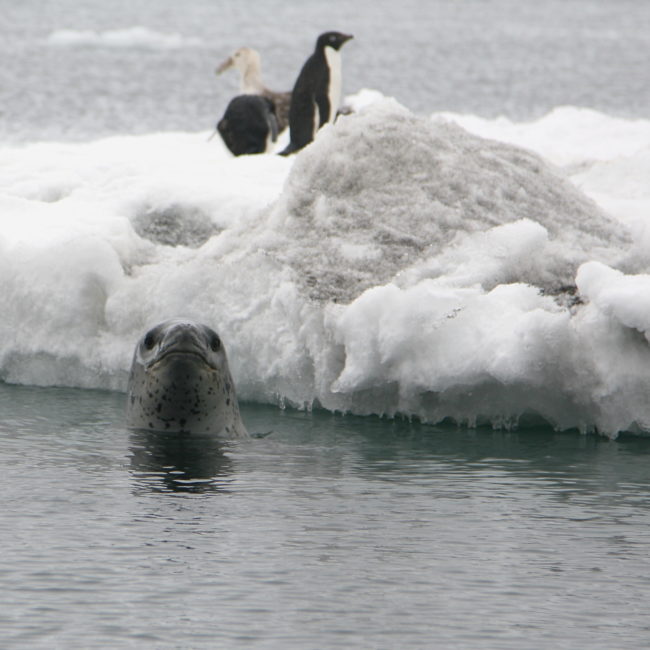Imagine exploring the Great Antarctic, a vast, tranquil ocean and a frozen area spanning 14 million square kilometers of the driest, highest, and coldest continent. Here temperatures can range from -10 degrees Celsius along the beach to -60 degrees Celsius inland.
Even though they threaten human habitat and scientific intervention, they also are a tremendous chance for the planet’s varied, living biodiversity.
As one travels along the dispersed ice, there is quite a chance we could encounter a large seal on one of the ice floats, basking in the sun, probably taking an afternoon nap.

If on a block of more extensive ice, one may even witness a penguin sharing its space with the seal at a safe distance. The seal raises its head to look at the approaching boat.
One cannot miss that cute and endearing smile of the animal. After concluding that the seals are not in danger, the seal returns to slumber.
Now, do not be fooled by the adorable grin on his face or his relaxed attitude; as, once he has eased into the water and his game, then you have one of the fastest and fiercest hunters of the ocean, an apex predator, next only to the killer whale.
His barbaric hunting methods spare no mercy to the penguins, fish, and other marine life at sea. The seals’ huge bone-crushing teeth have killed sharks.
Frequently referred to as the Lord of the Sea, the Leopard Seal, Hydrurga leptonyx, is deadly.
The seals were first described by French zoologist Henri Marie Ducrotay de Blainville back in 1820. Their scientific name “Hydrurga Leptonyx” literally means thin-clawed water worker.
The seal is a species of marine mammals called pinnipeds, commonly found chiefly in regions of Antarctica.
Seal are members of the “Pinnipeds” family of animals. This Latin word refers to marine mammals having front and rear flippers and means “fin or flipper-footed.”
Seals, sea lions, and walruses fall under this category. Though marine, they seem to have a very similar resemblance to a weasel, raccoons, skunks, or bear. Its closest living relatives and its neighbors.
Pinniped ancestors lived on land millions of years ago and might have spent more time in the water, gradually becoming acclimated and suited to the marine environment.
There are 18 different species of seals. The size of seals ranges from 3 feet 3 inches for the Balkan seal to 16 feet for the southern elephant seal, which ranks as the largest carnivoran.
Leopard seals are the largest and fastest seal species, and they have been witnessed hunting and eating other seals.
Second, only to the elephant seal in size can they reach up to 2.5/3.5m (8/11.5 feet) in length and weigh up to 600 kg (1300 pounds).
Their diet consists of krill, fish, squid, penguins, and other seals. Yes, Cannibalism is more common than thought in grey seals, as in they sometimes eat their species.
They are the only members of the seal family that feed on other types of seals regularly.
Their main predator is killer whales, polar bears, larger seals, giant sharks, and human beings. Yes, human beings, too, mainly because of global warming.
Who are the seals?
The distinguishing feature of the seals is their sizeable round head (like a rugby ball), which appears disproportionately large compared to their body.
Seals also have a long snout and japing jaws, giving them a reptilian appearance. The dark-colored fur on its back and light-colored stomach allow it to melt into pale ice or the dark blue sea. They aren’t renowned for being outgoing and like to be alone.
The seal’s land equivalent has spots and body markings (perfect for concealment), a solitary lifestyle, and hunting skills. Can you figure out what kind of animal we’re talking about, The leopard?
Both these animals have become opportunistic predators and similarly ambush their prey.
Did You Know – All seals have different features?
For Instance – The Leopard seals are members of the ‘true seal’ group. Unlike other seals, like the fur seal and sea lions, they do not have external ears.
Did You Know – The most accurate method used to determine a seal’s age is to study its teeth.
For Instance – like humans, seals also have dental issues like infection and damage, which gives researchers the best or closest age estimation.
Seals have evolved several clever adaptations to live with their surroundings.
Seals have two long wing-shaped fins and a streamlined body that gives them grace and speed underwater.
They have a thick coating of fat called blubber (like whales) that sits just beneath their skin and helps insulate them from the harsh temperatures of Antarctica, keeping their bodies warm.
When they dive, they have more blood and myoglobin. A chemical meant to store and deliver oxygen to the muscles.
Along with a lower heart rate, it allows them to stay underwater for more extended periods without a surface for air.
However, on land, their locomotion is described as wriggling – a series of muscular body ripples with some assistance from the front flipper, crunching and lengthening their body along the ground (more like a caterpillar).
These seals are extremely slow on land and stand no chance of chasing penguins or other land prey.
Do seals and penguins live in the same habitat?
These paedophilic “ice-loving” seals inhabit the Arctic and Antarctic waters and ice pack formations.
In the Southern Hemisphere, they have been sighted and recorded on shorelines such as the coasts and islands of Australia, New Zealand, South America, and South Africa.
Six seal species live in Antarctic waters: Ross, Weddell, crabeater, leopard, fur, and elephant seals.
On the other hand, penguins are observed in the Southern Hemisphere, such as Antarctica, New Zealand, Australia, South Africa, South America, and the Galapagos Islands, to mention a few.
How do the seal’s hunt penguins?
Seals’ jaws are designed with solid canines to catch food in a certain way.
However, their back teeth lock together in a way that allows them to strain krill from water, like how baleen whales sieve krill.
The food of a Seal varies depending on its size. Smaller seals eat krill, fish, squid, and penguins, while larger seals hunt for marine animals like penguins and other seals in their family.
Penguins form the primary diet for leopard and fur seals, primarily the chin-strapped and gentoo penguins.

Seals can swim at paces of up to 25 mph (40 km/h) under the water. Despite their weight, this characteristic allows them to launch themselves onto the ice from the water.
Male elephant seals often dive for more than 60 minutes at a time, and the depth record for this species is an incredible 7,835 feet (2,388 m). Yet, they stay close to the open water for easy access to thrust themselves on ice.
Seals are faster than penguins in the water, making them great hunters in the ocean. Most penguins swim underwater at around four to seven miles per hour (mph), but the fastest penguin—the Gentoo penguin – can reach top speeds of 22 mph!
The most strategic technique for seals to hunt penguins is by floating in waters near edges of ice or land where penguins have gathered.
Penguins and the Seal sometimes compete for the same food. The food in question is a crustacean that is only a few centimeters long, called Krill, and plays an essential part in the ecology.
Krill, tiny in size but massively large in number, is the sustenance of the Antarctic life. The concentration of krill depends on climate and current. During years of krill shortage, penguins appear more frequently on the seal’s menu.
How does the seal stalk a penguin?

The seal’s way of dealing with penguins is quite gruesome. It indeed is not a sight for the faint-hearted or one wishing the prey to escape such a painful ordeal.
One may even wish the seal kills its prey instantly than make it suffer so much, as the whole process could take a lengthy 15-20 minutes.
Seals are ruthless carnivores’ predators. Seals can swim much faster than penguins, so their approach to killing a penguin is to hunt it down using its much speedier swimming speeds.
Also, seals can be pretty cunning too, and they hide in the water until a penguin passes by close enough that it swims a short distance and grab it by its feet.
When the seal captures the penguin’s head or feet, it swings it forcefully in a broad arc and smacks it against the sea’s surface, similar to a dog thrashing its victim.
The thrashing continues until the penguin’s skin and feathers are entirely stripped away by the seal.
Seals are picky eaters for penguins and leave the skeleton, feet, and head behind.
A process known as ‘degloving’ involves removing the skin off the carcass and biting into portions before swallowing.
If you are seeing floating penguin skins in the sea? You are sure to spot a seal nearby.
On primarily solitary hunters, rarely associate themselves with others of their kind to capture large prey. But most often, they hunt alone.
For Instance – Some seals, such as the California sea lion, work together with dolphins to catch large schools of fish. Many seals travel great distances and dive to great depths in search of prey.
Sometimes two seals patrol the same area to hunt down their prey, the penguins. Encounters between two seals are generally aggressive, but they occur in silence. They are said to attempt to preserve the calm of their hunting areas.
Oddly enough, while rivals in water, the seals willingly share their ice floats at naptime. To do so, though, they must first lift their enormous mass out of the water.
Why they chose the difficult task of climbing onto the ice floats at this time of year remains a mystery. The reason may be since the ice floats serve as mobile dormitories.
Like all great predators, the seals play an integral part in the ecosystem. They are at the top of the food chain in Antarctica. Seals regulate the penguin population. Hence, despite its apparent cruel antique, it performs an essential role.
Why do seals eat penguins?
Seals hunt and eat penguins mostly to live and to satiate needs for sufficient and ongoing energy and nutrients.
We all know that most animals love eating penguins due to their high nutritional content and distinct fat layers. The same goes with a seal.
How do seals communicate among themselves?
Unlike sea lions known for their loud barks, seals communicate with vocalizations called “trills” or “hoots.”

They sing underwater during mating season, mainly short-distance local or broadcast calls that reach long distances. These noises are assumed to be part of a “long-range acoustic show” used to attract a mate or achieve territorial goals.
Females are known to vocalize when they have elevated reproductive hormones helping them find a mate and get their pup’s (baby seal’s) attention when returning to the ice after a foraging trip.
Between November and March, males and females mate in the water, and the pups are born roughly 274 days later. However, the nuances of their mating activities remain a mystery.
Their dispersal and the fact that they spend so much of their time underwater, seals are challenging to study.
Seals are loud, especially during the summer. Before attacking, they frequently give out a terrifying growl.
Named after the land animal leopard, the leopard seal is equally as lethal and shares many qualities as the leopard.
Why are they named after the leopards? Leopard Seals got their common name from the collection of black Leopard-like spots.
Seals are friendly, which means they don’t dwell in packs. They prefer a solitary existence only when they meet to mate or exploit a communal food supply such as a large penguin colony.
Seals are more than capable of injuring or killing a human. An accounted human kill and a few documented attacks have put them on a potentially dangerous to human list.
Seals do not encounter many humans, which helps them survive.
Yet, they often interact with divers, showing great curiosity, and often a rather disturbingly sizeable open mouth full of big sharp teeth too.
Many attacks by seals have been under a surprise circumstance, which fits well with the seals being ambush predators.
However, on the contrary, there has been an instance where a female seal brought live penguins to an underwater photographer to try to teach him how the seal hunts.
Seals Conservation Status
The worldwide population of leopard seals is estimated to be between 200,000 and 400,000, an extensive range that places them on the IUCN’s Red List as ‘Least Concern.’
Under the ‘Antarctic Treaty’ and the ‘Convention for the Conservation of Antarctic Seals,’ they are protected by law.
In NZ, the Leopard seals are considered a taonga (treasure) for the people of the land.
As a result, the “Marine Mammals Protection Act (1978) ” prohibits disturbing, harassing, damaging, wounding, or killing a seal illegally, protecting them as well. Anyone guilty of such a crime might face a lengthy jail sentence or a hefty fine.
Though seals are safer than other aquatic creatures, their numbers may decrease in the following years. Melting icebergs due to global warming can directly influence their eating patterns, and hence their numbers remain a catastrophe in the making.
Final Thoughts
Seals live in both the Southern and Northern Hemisphere. In the southern hemisphere, varieties of seals such as fur seals and leopard seals regularly eat penguins on land and in the sea. A significant part of their diet comprises penguins.
The facts to get cleared with answers are indeed interesting. I hope you got the response to the factual discussion that happened one day with your friends or family where you left the space filled with sheepish smiles.
Images Source
Seals basking in the sun by pxhere / CC BY
Seals amongst penguins by Liam Quinn / CC BY
seal stalking a penguin by Grant.C / CC BY
seals communicate with vocalizations by Sonse / CC BY
References
https://oceanwide- expeditions.com/to-do/wildlife/leopard-seal
https://www.leopardseals.org/species-identification/
https://www.coolantarctica.com/Antarctica% 20fact%20file/wildlife/leopard-seal.php
https://australian.museum/learn/animals/ mammals/leopard-seal/
https://www.nationalgeographic.com/animals/mammals/ acts/leopard-seal?loggedin=true
https://leopardseals.janhenrydesign.com/leopard-seal-facts/